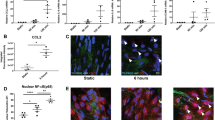Abstract
Background
Implantation of a retrievable vena cava filter (VCF) is an effective method for preventing pulmonary embolism. Retrieval of filters, however, may be difficult due to intimal hyperplasia and inflammation in the cava wall. The transcription factor nuclear factor-kappaB (NF-κB) plays an important role in regulation of numerous genes participating in the inflammatory and proliferative responses of cells. The present study was to determine whether VCF implantation resulted in activation of NF-κB in the venous neointima.
Methods
Filters were placed in vena cava (VC) in four swine for 30 days and then removed. Intimal specimens adhering to the filter struts were analyzed with reference to normal VC tissues. Immunohistochemical analyses were used to assess the NF-κB subunits p65 and p50 and the phosphorylated inhibitor of κB-α (phosphor-IκB-α) in the tissues. NF-κB DNA-binding activity was measured with enzyme-linked immunosorbent assay.
Results
As compared to normal VC tissues, the intimal tissues contained higher percentages of cell nucleus-located p65 and p50, and NF-κB DNA-binding activity. Elevated immunoreactivities of p65, p50 and phosphor-IκB-α were also present in the intima.
Conclusion
The present study demonstrates for the first time that VCF implantation caused NF-κB activation in neointima. We further demonstrate the activation is at least partly due to phosphorylation of IκB-α. Our data suggest that NF-κB activation would significantly contribute to development of intimal hyperplasia and inflammation in filter-inserted vena cava walls. NF-κB might be a therapeutic target for inhibiting filter-induced neointima and improving filter retrieval.





Similar content being viewed by others
References
Montgomery JP, Kaufman JA. A critical review of available retrievable inferior vena cava filters and future direction. Semin Interv Radiol. 2016;33(2):79–87.
Ashley DW, Mix JW, Christie B, Burton CG, Lochner FK, McCommon GW, Matoy GC, Solis MM, Dormer RS, Dalton ML, Tyson CS, Newman WH. Removal of the OptEase retrievable vena cava niter is not feasible after extended time periods because of filter protrusion through the vena cava. J Trauma. 2005;59(4):847–52.
Christie DB, Kang J, Ashley DW, Mix W, Lochner FK, Solis MM, Newman WH, Dalton ML, Wang Z. Accelerated migration and proliferation of smooth muscle cells cultured from neointima induced by a vena cava filter. Am Surg. 2006;72(6):491–6.
Rimon U, Volkov A, Garniek A, Golan G, Bensaid P, Khaitovich B, Abu-Salah K, Zissin R, Simon D, Konen E. Histology of tissue adherent to OptEase inferior vena cava filters regarding indwelling time. Cardiovasc Interv Radiol. 2009;32(l):93–6.
Hoekstra A, Hoogeveen Y, Elstrodt JM, Tiebosch AT. Vena cava filter behavior and endovascular response: an experimental in vivo study. Cardiovasc Interv Radiol. 2003;26(3):222–6.
de Gregorio MA, Gimeno MJ, Tobio R, Lostale F, Mainar A, Beltran JM, Madariaga B, Alfonso ER, Medrano J, Viloria A. Animal experience in the Gunther Tulip retrievable inferior vena cava filter. Cardiovasc Interv Radiol. 2001;24(6):413–7.
Arabaci T, Cicek Y, Canakci V, Canakci CF, Ozgoz M, Albayrak M, Keles ON. lmmunohistochemical and stereologic analysis of nf-kb activation in chronic periodontitis. Eur J Dent. 2010;4:454–61.
Landry DB, Couper LL, Bryant SR, Lindner V. Activation of the NF-kappa B and 1 kappa B system in smooth muscle cells after rat arterial injury. Induction of vascular cell adhesion molecule-1 and monocyte chemoattractant protein-1. Am J Pathol. 1997;151(4):1085–95.
Yoshimura S, Morishita R, Hayashi K, Yamamoto K, Nakagami H, Kaneda Y, Sakai N, Ogihara T. Inhibition of intimal hyperplasia after balloon injury in rat carotid artery model using cis-element ‘decoy’ of nuclear factor-kappaB binding site as a novel molecular strategy. Gene Ther. 2001;8(21):1635–42.
Kong L, Choi RC, Tsim KW, Jing N, Nakayama DK, Wang Z. Distribution and expression of Kirre, an IgSF molecule, during postnatal development of rat cerebellum. Neurosci Lett. 2013;543:22–6.
Halle M, Gabrielsen A, Paulsson-Berne G, Gahm C, Agardh HE, Farnebo F, Tornvall P. Sustained inflammation due to nuclear factor-kappa B activation in irradiated human arteries. J Am Coll Cardiol. 2010;55(12):1227–36.
Agley CC, Velloso CP, Lazarus NR, Harridge SD. An image analysis method for the precise selection and quantitation of fluorescently labeled cellular constituents: application to the measurement of human muscle cells in culture. J Immunol Methods. 2005;301(l–2):102–13.
Kirkeby S, Thomsen CE. Quantitative immunohistochemistry of fluorescence labelled probes using low-cost software. J Histochem Cytochem. 2012;60(6):428–38.
Wang Z, Castresana MR, Detmer K, Newman WH. An IkappaB-alpha mutant inhibits cytokine gene expression and proliferation in human vascular smooth muscle cells. J Surg Res. 2002;102(2):198–206.
Auberger P, Baeuerle PA, Peyron JF. Tyrosine phosphorylation of I kappa B-alpha activates NF-kappa B without proteolytic degradation of I kappa B-alpha. Cell. 1996;86(5):787–98.
Cercek B, Yamashita M, Dimayuga P, Zhu J, Fishbein MC, Kaul S, Shah PK, Nilsson J, Regnstrom J. Nuclear factor-kappaB activity and arterial response to balloon injury. Atherosclerosis. 1997;131:59–66.
Birukov KG. Cyclic stretch, reactive oxygen species, and vascular remodeling. Antioxid Redox Signal. 2009;11(7):1651–67.
Acknowledgements
A version of this manuscript was presented at 2017 Annual Meeting of the American Association for the Surgery of Trauma (AAST), September 13–16, 2017, Baltimore, MD.
Funding
This study was supported partly by a grant from the Navicent Health Foundation (Grant Number: 60827116).
Author information
Authors and Affiliations
Contributions
ZW performed literature search, study design, data interpretation, and writing and critical revision. LK and JK conducted data collection and analysis. DWA, DKN and PSD contributed to critical revision of the manuscript. All provided final approval of the present version for publication.
Corresponding author
Ethics declarations
Conflict of interest
The authors declare that they have no conflict of interest.
Ethical Approval
All applicable international, national and/or institutional guidelines for the case and use of animals were followed.
Consent for Publication
For this type of study, consent for publication is not required.
Electronic supplementary material
Below is the link to the electronic supplementary material.
Rights and permissions
About this article
Cite this article
Wang, Z., Ashley, D.W., Kong, L. et al. Nuclear Factor-κB is Activated in Filter-Implanted Vena Cava. Cardiovasc Intervent Radiol 42, 601–607 (2019). https://doi.org/10.1007/s00270-018-2138-2
Received:
Accepted:
Published:
Issue Date:
DOI: https://doi.org/10.1007/s00270-018-2138-2




